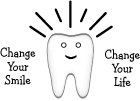Braces for Adults
Braces aren’t just for teenagers. No matter your age, it’s never too late to improve your dental health and beautify your smile. About 1 million Americans and Canadians over the age of 18 are getting braces. As a result, general practitioners today are more familiar with potential concerns and special needs of their adult patients. Some general dentists have the training to diagnose and treat orthodontic problems.
Some adults never received orthodontic treatment as children to correct problems such as crooked or crowded teeth, overbites, underbites, incorrect jaw position, or jaw joint disorders. If left untreated, these problems can result in tooth decay, gum disease, headaches, earaches, as well as speaking, biting or chewing problems
Like children, adults can receive the same benefit of an improved smile and oral health from wearing braces. However, since adults are no longer growing, treatment may take longer than it does for teenagers. The average adult wears braces for 18 months to three years. After braces are removed, you may need to wear a retainer to maintain the results of your treatment.
Consult with your dentist and ask for an evaluation. Many general practitioners have received additional training in orthodontics and have chosen to incorporate it into their practice. Depending on the complexity of your case and whether or not your dentist performs orthodontic work, he or she may choose to treat you or refer you to an orthodontist, a dentist who specializes in the diagnosis, prevention and treatment of dental and facial irregularities. An orthodontist has completed two to three years of advanced education in orthodontics in addition to a four-year dental graduate program. Most initial consultations provide an opportunity to ask questions about orthodontic treatment.
Several orthodontic treatment options are available to adults. Braces are custom-made appliances that use gentle pressure to straighten your teeth and correct your bite. While some practitioners still favor metal braces as the most reliable, new materials and other advances offer smaller, less noticeable braces than were available a generation ago, and these materials are equally effective. Instead of metal, you can opt for clear or neutral-colored ceramic braces, or removable invisible aligners known as Invisalign. Ask your dentist for a recommendation on which type of braces would provide the best results for you.
The cost of orthodontic treatment depends on the type of braces recommended by your dentist. Check with your major medical or dental insurance provider to determine if your plan covers orthodontic work.
Once you begin orthodontic treatment, it’s a good idea not to eat foods that can damage or dislodge braces. Hard foods such as candy, raw carrots, corn on the cob, pretzels, nuts, popcorn and crushed ice are off limits. Sticky foods to avoid include caramel, taffy and gum. These foods can get stuck between teeth and gums or bend wires and knock bands or brackets loose. If this results in damage to braces, treatment may be extended.
Remember to see your dentist for regular check-ups during orthodontic treatment. Going to the orthodontist is not a substitute for regular dental checkups. If you’re going to invest time and financial resources in a healthy smile, be prepared to go the distance to achieve results. That means you should consult your dentist for a schedule that’s appropriate for you.

